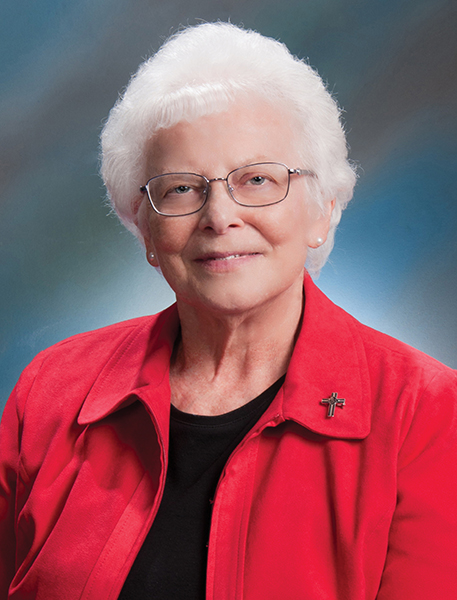
Dear friends and family,
Sister Edna Hess • President, Sisters of the Precious Blood
Spring moving into summer seems to have finally arrived after winter’s multiple returns. Nature speaks of new life everywhere we look. The birds are singing, and babies are being born. All shout “Alleluia” to Jesus who is risen from the dead.
Holy Week with the remembrance of Jesus gifting us with His Body and Blood, his death on the cross and His resurrection on the third day have come and gone and we celebrate the coming of the Holy Spirit, the birth of the Church. This issue of Sharing & Caring, dedicated to the Eucharist, is so appropriate for this time of the Church Year. In Eucharist we remember and we celebrate Jesus’ death and resurrection every time we celebrate the Mass. Or in the words of Pope Francis: “To let ourselves be nourished by the Bread of Life means to be in tune with the heart of Christ, to assimilate his choices, thoughts, behaviors.” It also means that we enter into “a dynamism of sacrificial love and become persons of peace, forgiveness, reconciliation and sharing in solidarity,” he adds.
As I reflected on my own history with the Eucharist, I remembered how as a child my parents took us to Mass as often as possible. Even though I attended a public school, we had Mass every day of the week before starting school. Around the time when I was in seventh or eighth grade, changes started happening with the Mass. We were able to use English in the opening prayers of the Mass, which made it possible to understand what we were saying.
Of course, when I entered Fatima Hall, the aspirancy of the Sisters of the Precious Blood, we also had daily Mass. During my years of formation, things were radically changing in the Church. The Second Vatican Council was taking place, and one of its important documents was the “Constitution on the Sacred Liturgy,” which brought many changes to the way the Eucharist was celebrated. Having the priest celebrate facing the people instead of with his back to the people was a clear sign that this celebration involved all those who were present. Being able to hear the prayers, readings and acclamations in English helped laypeople participate more fully, instead of praying a rosary while Mass was being celebrated. Having experienced the “old” way and then the “new” way to celebrate liturgy, I find it difficult to understand why some young priests today want to go back to celebrating Mass with their backs to the people and in Latin, which is not even a language people speak or understand.
I hope you will enjoy getting in touch with what Eucharist means for us Sisters of the Precious Blood and how it inspires us to go from Eucharist to live in love and to work for peace and justice. A few of this year’s Jubilarians share their reflections on how Eucharist motivates and sustains them. We also share about Mother Brunner’s devotion to the Eucharist. Our foundress would go to Mass as often as possible and received communion whenever she attended Mass, which was very unusual at that time in history.
Also, with this column, I am saying goodbye. It has been a privilege to share with you in Sharing & Caring. At the end of June, we shall be electing a new leadership team, so when you receive your next edition of Sharing & Caring, you will find someone new sharing with you. May the Lord bless you and fill you with His love.
United in love,
Sister Edna





